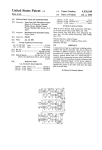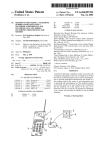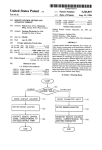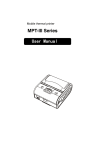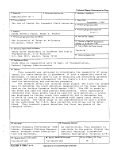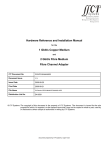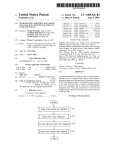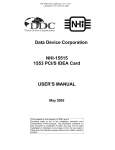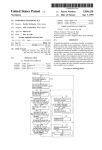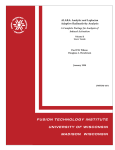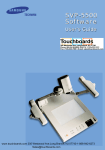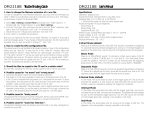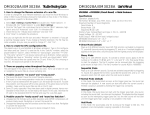Download Self-pacing serial keyboard interface for data processing system
Transcript
United States Patent [191 [11] [45] Eggebrecht et al. [54] SELF-FACING SERIAL KEYBOARD Jul. 17, 1984 Dec. ’79. IBM Personal Computer Reference Manual, Aug. ’81, pp. D-IO and D-12. [75] Inventors: Iewis C. Eggebreeht, Rochester, Minn; Jesus A. Saenz, Coral Springs, Primary Examiner-Edward J. Wise Attorney, Agent, or Firm-Sughrue, Mion, Zinn, Macpeak and Seas [57] ABSTRACT Fla. International Business Machines Corporation, Armonk, NY. [21] Appl. No.: 292,070 [22] Filed: Aug. 12,1981 A serial keyboard interface (28) connects a self scanning programmable serialized keyboard (40) to the system [51] Int. c1; ............................................ .. oosr 15/02 [52] u.s.c1. .................................. “ass/zoo; 364/518; bus (10) of a data processing system. A cable (42) con taining only a clock wire (52) and a data wire (58) pro vides the connection. The keyboard transmits a 9-bit scan out code consisting of a start bit followed by eight serial data bits. The keyboard clock line (52) is con nected to the clock or shift terminal of a serial-to-paral lel shift register encoder (62) for shifting the data bits on 364/900 364/200 MS File, 900 MS File, 364/518; 340/365 R, 365 S References Cited [58] Field of Search [56] 4,460,957 tus”, IBM Technical Disclosure Bulletin, vol. 22, No. 7, INTERFACE FOR DATA PROCESSING SYSTEM [73] Assignee: Patent Number: Date of Patent: data line (58) into the encoder which has eight parallel U.S. PATENT DOCUMENTS output data lines (A, B . . . G, H) connected to the 3,501,749 3/1970 Cuccio .............................. .. 364/900 system bus. When the encoder (62) contains a complete 3,980,994 9/1976 scan out frame, the start bit is in the most signi?cant Ying et a1. . . . . . . . . . . . . .. 364/200 4,126,898 11/1978 Spangler et a1. 4,386,410 5/1983 364/900 stage (h’) and sets the D-type latch (68) to apply a CPU interrupt request to the system bus (10). At this time, the 6 output of latch (68) pulls down the data line to Pandya et al. .................... .. 364/518 FOREIGN PATENT DOCUMENTS 2005448 ground potential, thereby disabling the data line and preventing further keyboard transmission of data. When the interrupt request is granted by the CPU, a 4/1979 United Kingdom . OTHER PUBLICATIONS M. D. Alger et ai., “Remote Keyboard Interface", Wireless World, vol. 87, No. 1545, Jun. '81, pp. 77-78. “An 8048-Based Keyboard/Display Module", Wescon Conference Record, Sep. 1977, 27/2 pp. 1-4. clear signal resets latch (68) to remove ground potential from data line (58) and thereby permit further transmis sion of data. 14 Claims, 3 Drawing Figures R. A. DuPont et ai., "Serializer/Deserializer Appara __ _, g . / 2 | 22 ' ill/00s — 2/ : m PROGRAMMABLE KEYBOARD RESET |2\ CPU l6\ 1 1 | MIA 2o\ 1 R05 BM an |4~ : 2a \ mu INT REO '"iié‘é : 4R ammo ' 40; :Tu'ti'nhi? ; i s24 I . ,.______- J ,B\ i 1 DISPLAY 1 32 ADAPTER I INTERRUPT CONTROLLER ; msx /26 , 35 | l ADAPTER 3° US. Patent Jul. 17, 1984 shw 1 of2 5 I; I E 5/10 /22 DI/DOs ' I l PROGRAMMABLE 5-2 KEYBOARD |2\ CPU ‘6 RESET I | \ DNA 2o\ | I ROS : 2B\ KYBD : 42\ RE INEEEE 8m 4,460,957 '| _~___°_ RAM :INTERRUPT ‘4w I 824 I r--------1 | 4o; I ' |a\ I KEYBOARD I so I 32 DISPLAY | ADAPTER I \ l INTERRUPT W . : CONTROLLER DISK ADAPTER 26 I I 38 3 I F|G.l 34} I-————|::I [s DISKETTE DRIVE DISKETTE ‘DRWE H63 KEYBOARD n n r] n n CLOCK OUT D P F‘ KEYBOARD ! ' = ‘ o 1 l DATA ()UT ,__.| I I cPu INTERRUPT REG‘ 53:?‘ LJ . I I I I i ' ' 1 o o | ' m PEEIEIEEEEOE ' | o [_ 4,460,957 1 2 More particularly, a three-state system bus 10, includ ing address, data and control lines, interconnects the basic components of the computer to provide for the necessary transfer of address, data and control signals among these components. The components include, for SELF-FACING SERIAL KEYBOARD INTERFACE FOR DATA PROCESSING SYSTEM TECHNICAL FIELD This invention relates generally to the ?eld of inter face circuits for controlling two-way communication between a keyboard and a data processing system and, example, the central processing unit (CPU) 12, a dy namic random access memory (RAM), a multiple chan nel programmable direct memory access (DMA) con troller 16, an interrupt controller 18, a read-only storage more particularly, to a self-pacing interface which per (ROS) 20, DI/DO’s 22, a display adapter 24, a disk adapter 26 and a keyboard interface 28. A cathode ray tube display device 30 may be con nected by a cable 32 to the display adapter 24. A pair of mits such communication using only two wires between the interface and the keyboard. BACKGROUND OF THE INVENTION diskette drives 34 and 36 may be connected by a cable Keyboard entry control circuits or interfaces are 38 to the disk adapter 26. A keyboard 40 is connected by generally well-known in the prior art; however, they a cable 42 to the keyboard interface 28. In this preferred embodiment, the CPU 12 is an Intel are quite complex and require more than two wires between the keyboard and the interface, including, in microprocessor 8088 which is fully disclosed in “The addition to two wires for carrying clock and data sig 8086 Family User’s Manual, October 1979", published nals, respectively, status lines for indicating the statuses 20 by Intel Corporation, Santa Clara, California“. The of the keyboard and central processing unit, respec DMA controller is an Intel 8237 high performance tively. Representative prior art keyboard entry control programmable DMA controller also fully disclosed in circuits and interfaces are disclosed in the following US. Pat. Nos. 3,50l,749; 3,533,078; 4,044,398; 4,126,898 and 4,170,768. the above Intel Corporation publication. RAM 14 is any 4,038,640; conventional dynamic memory, such as a T] 4116. Inter 25 rupt controller 18 is an Intel 8259 chip. ROS 20 is also conventional and may be a Mostek MK 3600, for exam SUMMARY OF THE INVENTION ple. DI/DO 22 is a digital input/digital output interface, The present invention eliminates the need for the complex keyboard interfaces of the prior art while, at such as an Intel 8255A general purpose programmable peripheral interface chip. the same time, requiring only two wires between the 30 Keyboard interface 28 is the subject of the present interface and the keyboard. The novel interface of the invention and is illustrated in detail in FIG. 2. invention provides the following features: Keyboard 40 is a programmable self-scanning serial 1. Keyboard data rate and clocking are not tied to any speci?c clock frequency, and data may be sent at any rate. 2. The only timing relationships required are set-up and hold time required with respect to the rising edge of the keyboard clock; thus, such relationships are easy to implement in microcode. 3. Capability of supporting two-way communications between the keyboard and central processing unit (CPU) of the data processing system. 4. Full handshake and synchronous operation. 5. Relatively few components as compared to prior ized keyboard which transmits a scan code of 8 series data bits identi?ed in the various key positions. The 35 scan code also includes a start bit; thus, each serial scan code is contained in a 9-bit frame headed by the start bit. Also, in the preferred embodiment keyboard 40 is of the capacitive matrix type and has 83 key positions. The keyboard contains its own microprocessor, such as an 40 Intel 8048, and has an OUT CLOCK line, a SENSE CLOCK line, an OUT DATA line and a SENSE DATA line. Furthermore, each key is capable of make/break and typamatic operation. The keyboard contains self-scanning logic and interface controls art interfaces. 45 which will support the protocol for keyboard interface The presence of one or the other of two voltage 28, which protocol is described below. levels on the two lines connecting the keyboard and interface functions to control resetting of the keyboard Keyboard 40, itself, forms no part of the present in vention and its circuits and construction are found in and transmission of keyboard data. copending application Ser. No. 6l,7l9, ?led July 30, For a better understanding of the present invention, 50 1979 and in the following US. Pat. Nos: 3,786,497; together with other and further advantages and features 3,92l,l67; and 4,118,611; all of which are incorporated thereof, reference is made to the following description herein by reference. taken in connection with the accompanying drawings, In general, keyboard interface 28 is self-clocked or the scope of the invention being pointed out in the ap self-paced in that it is clocked or paced by the transmis pended claims. sion of the keyboard clock and data, completely inde pendently of any other clock rates in the computer or BRIEF DESCRIPTION OF THE DRAWINGS data processing system. When either the system bus is FIG. 1 is a block diagram of a data processing system sending a reset command to the keyboard upon power up or else the interface has not processed a previous including the novel interface of the invention. FIG. 2 is a logic block diagram illustrating the details of the novel interface of the invention. FIG. 3 is a timing diagram of the operation of the scan code frame, the keyboard is prevented by its con trol logic from transmitting data. When a complete scan code frame has been stored in the interface, a latch is set to generate an INTERRUPT REQUEST to the CPU via the interrupt controller. When the INTERRUPT interface illustrated in FIG. 2. DESCRIPTION OF THE PREFERRED EMBODIMENT FIG. 1 is a block diagram ofa small computer or data processor, such as a so-called personal computer. 65 REQUEST is granted and the data is transferred to the CPU, the latch is cleared or reset to signal the keyboard via its data line that another scan code may be transmit ted to the interface. Only two lines are required in the 3 4,460,957 cable connecting the interface and the keyboard in order to perform all of the data, clocking and status 4 sensing functions. The keyboard tests or senses DATA line 58 via the SENSE DATA line 57. If the DATA line is DOWN, then the computer or data processing system has not More particularly, and as illustrated in FIG. 2, the SENSE CLOCK line 50 is tied to the keyboard OUT CLOCK line 52 at junction 54, and an open-collector processed the previous scan code which had been trans mitted to the interface 28 (and the Q output of latch 62 is still DOWN or 0). Thus, the keyboard is disabled and (OC) gate 56 (such as an SN 7407 shown in Texas In waits for the DATA line 42 to go to l or UP. When, or struments’ “The TTL Data Book”, second edition, 1976) is connected in the OUT CLOCK line 52 between if, DATA line 58 is UP, then keyboard 40 transmits via the keyboard control logic and the junction 54. Further line 58 a nine-bit frame beginning with a start bit fol 0 lowed by eight series DATA bits representing the scan code identifying a particular key position of the key more, the keyboard SENSE DATA line 57 is tied to the OUT DATA line 58 at the junction 60, and another open-collector (OC) gate 61 is connected in the DATA line between junction 60 and the keyboard control board. As shown in FIG. 3, the start and eight-data bits are clocked or shifted into the nine-stage encoder 62 under the control of the keyboard OUT CLOCK. Note that the OUT CLOCK is not necessarily periodic, but that the data bits track the OUT CLOCK; thus, interface 28 is not tied to any specific clock frequency within the logic. Cable 42, containing ony the CLOCK line 52 and the DATA line 58, connects keyboard 40 to the novel keyboard interface 28. Interface 28, itself, requires only four wires: the keyboard CLOCK and DATA lines, a system, but rather is paced by the keyboard 40. During +5 volt (+5 V) and a ground (GND) or zero volt line. Interface 28 contains a serial-to-parallel shift register 20 the transmission of the scan code frame via DATA line 58, interface 28 is under the control of the keyboard 40, (74LS299) encoder 62 having a CLOCK terminal 64 and a SERIAL IN terminal 66 for receiving the serial and latch 68 is in its cleared or reset state with its Q scan code frame on the DATA line 58 from keyboard output UP whereby DATA line 58 also UP. 40. Encoder 62 has nine stages and eight corresponding However, when all nine bits of the scan code frame parallel DATA output lines, labeled A, B . . . E, H and 25 have been shifted or clocked into the encoder 62, the start bit in the most signi?cant stage is clocked by the a start line, labeled h’. Stage A is the lowest ordered or OUT CLOCK to the D input of latch 48, thereby set least significant stage, and stage h’ is the highest ordered or most signi?cant stage. The most signi?cant stage ting the latch, raising the Q output to send the INTER output line h’ is connected to the D input terminal of a RUPT REQUEST to the system bus, and lowering the D-type edge-triggered latch 68. CLOCK line 52 is con 30 Q output, thus applying ground potential to DATA line nected to the CLK terminal of latch 68. The Q or set 58 and causing the DATA line to go DOWN; since the keyboard will sense by its SENSE DATA line 57 the output terminal of latch 68 is connected to the system DOWN condition of DATA line 58, the keyboard is bus 10 and transmits an INTERRUPT REQUEST prevented from transmitting any additional data. How ggnal to the CPU 12 via the interrupt controller 18. The Q or reset output line of latch 68 is connected through 35 ever, after the INTERRUPT REQUEST has been granted and the eight data bits transmitted in parallel another open-collector (OC) gate 70 to the keyboard from the encoder via DI/DO 22 to the system bus 10, a DATA line 58. The CLR or reset terminal of latch 68 is also connected to the system bus 10 and receives a CLEAR or reset signal from the CPU when an IN TERRUPT REQUEST has been granted and the eight CLEAR signal from the CPU is applied to the CLR terminal of latch 68, thereby clearing or resetting the 40 latch to cause the Q output to go UP and permitting DATA line 58 to return to the UP state which is sensed parallel data bits have been transmitted from encoder 62 via DI/DO 22 to a register in the CPU. The OC gates 56, 61 and 70 are functionally switches which, when closed, place ground or a zero (0) voltage by the keyboard SENSE DATA line 56 to permit the next scan code frame to be transmitted to the interface 28. While there has been described what is at present on the line to which their outputs are connected. In 45 considered to be the preferred embodiment of this in other words, ifa l or UP level appears on a gate input, vention, it will be obvious to those skilled in the art that then the gate output is a l (+5 V) or UP. various changes and modifications may be made therein without departing from the invention, and it is, there Now, the operation and protocol of keyboard inter face 28 will be described with reference to FIG. 2 and the timing diagram of FIG. 3. 50 fore, intended to cover all such changes and modifica tions as fall within the true spirit and scope ofthe inven tion. We claim: 1. In a data processing system including a system bus First, both the CLOCK line 52 and the DATA line 58 are tied to + 5 volts. The existence ofa +5 volts poten tial on the line will be referred to as the UP state of the line, whereas the existence of O or ground potential on a line will be referred to as the DOWN state. 55 When a key is depressed on keyboard 40, both the OUT CLOCK and DATA are generated. Initially the keyboard sets its OUT CLOCK to a l. The keyboard then tests or senses the CLOCK line 52 via the SENSE for transferring address, data and control signals among a central processing unit, a memory and a self-scanning serial keyboard, all connected to the bus, said keyboard having a clock line for transmitting a keyboard out clock signal and a data line for transmitting a serial scan CLOCK line 50 to determine whether the CLOCK line 60 out code in a frame headed by a start bit followed by a predetermined number of serial data bits identifying a is UP or DOWN. If the CLOCK line 52 is DOWN, the key position, an improved interface for providing two system is requesting keyboard 40 to execute a reset by way communication between the bus and the keyboard, virtue of a ground signal (RESET) from DI/DO 22 on the reset line 72. This condition can occur upon power up, and causes the keyboard to reset all of its circuits. 65 However, if the keyboard senses an UP state on CLOCK line 52, then keyboard 40 is enabled and tries to raise the DATA line 58. and comprising: serial-to-parallel shift register encoder means for stor ing in parallel the frame of serial bits under the control of the clock signal and having (1) a clock terminal connected to said keyboard clock line, (2) 5 4,460,957 6 8. An improved interface as de?ned in claim 7 further comprising means, coupled to the bus, for applying to said clock line a disabling signal to disable the out clock a serial data input terminal connected to said key board data line, (3) said predetermined number of parallel output data lines connected to the bus, and (4) a control line coupled to the most signi?cant stage of said encoder, said encoder having the same signal. number of stages as the number of bits in a frame, whereby, when said encoder contains said start bit comprising gate means, coupled between said data line and said Q reset output terminal, responsive to said signal and said predetermined number of data bits, disabling signal for applying ground potential to said a control signal is produced on said control line; data line. 10. In a data processing system including a system bus 9. An improved interface as de?ned in claim 7 further and control means, responsive to said control signal and to said keyboard out clock signal, for applying a central processing unit interrupt signal to the bus and for applying to said data line a disabling signal which prevents further transmission of data bits by 5 the keyboard, for transferring address, data and control signals among an interruptable central processing unit, a memory and a self-scanning serial keyboard, all connected to the bus, said keyboard having a clock line for transmitting a keyboard out clock signal and a data line for transmit ting a serial scan out code in a frame headed by a start bit followed by a predetermined number of serial data bits identifying a key position, an improved interface for providing two-way communication between the bus said control means also being responsive to a clear signal from the central processing unit to remove the disabling signal from the data line when said data bits have been transferred from said encoder 20 and the keyboard, and comprising: serial-to-parallel shift register encoder means for stor means to said bus, thereby permitting transmission ing in parallel the frame of serial bits under the of another scan code frame from the keyboard to control of the clock signal and having (I) a clock said encoder means. terminal coupled to said keyboard clock line, (2) a 2. An improved interface as de?ned in claim 1 serial data input terminal connected to said key wherein said control means comprises a D-type edge 25 board data line, (3) said predetermined number of triggered latch having its D input tenninal connected to parallel output data lines connected to the bus, and said control line, its clock terminal connected to said (4) a control line coupled to the most signi?cant clock line, its Q set output terminal connected to the stage of said encoder, said encoder having at least bus, its Q reset output terminal connected to the data the same number of stages as the number of bits in line, and its clear terminal connected to the bus, a frame, whereby, when said encoder contains said whereby said control signal sets said latch to generate start bit signal and said predetermined number of said interrupt signal on _s_aid Q output terminal and said data hits, a control signal is produced on said con~ disabling signal on said Q reset output terminal when an trol line; and entire scan code frame is stored in said encoder, said control means, responsive to said control signal and clear signal being applied to said clear terminal to reset 35 to said keyboard out clock signal, for providing an said latch and cause said Q reset output terminal to interrupt signal to said central processing unit and remove said disabling signal from said data line. for applying to said data line a disabling signal 3. An improved interface as de?ned in claim 2 further which prevents further transmission of data bits by comprising means, connected to the bus; for applying to said keyboard, said clock line a disabling signal to disable the out clock 40 said control means also being responsive to a clear signal and to reset the keyboard. signal from the central processing unit to remove 4. An improved interface as de?ned in claim 2 further the disabling signal from the data line when said comprising gate means, coupled between said data line data bits have been transferred from said encoder and said Q reset output terminal, responsive to said disabling signal for applying ground potential to said 45 data line. 5. An improved interface as de?ned in claim 1 further comprising means, connected to the bus, for applying to said clock line a disabling signal to disable the out clock \ means to said bus, thereby permitting transmission of another scan code frame from the keyboard to said encoder means. 11. An improved interface as de?ned in claim 10 further comprising means, coupled to the bus, for apply ing to said clock line a disabling signal to disable the out clock signal. 6. An improved interface as de?ned in claim 1 further 12. In a data processing system including a system bus comprising means, connected to the bus, for applying to for transferring address, data and control signals among said clock line a disabling signal to disable the out clock an interruptable central processing unit, a memory and signal and to reset the keyboard. 7. An improved interface as de?ned in claim 1 55 a self-scanning serial keyboard, all connected to the bus, said keyboard having a clock line for transmitting a wherein said control means comprises a D-type edge keyboard out clock signal and a data line for transmit triggered latch having its D input terminal coupled to signal. said control line, its clock terminal coupled to said clock ting a serial scan out code in a frame headed by a start line, its Q set output terminal providing said interrupt signal, its Q reset output terminal coupled to disable the bit followed by a predetermined number of serial data bits identifying a key position, an improved method for providing two-way communication between the bus data line, and its clear terminal coupled to the bus, whereby said control signal sets said latch to generate said interrupt signal on said Q output terminal and said disabling signal on said Q reset output terminal when an entire scan code frame is stored in said encoder, said 65 and the keyboard, comprising the steps of: serially shifting into a serial-to-parallel shift register encoder a frame of serial bits, received on said data line under the control of the keyboard clock signal; clear signal being applied to said clear terminal to reset when a start bit having a predetermined ?xed state is said latch and cause said Q reset output terminal to remove said disabling signal from said data line. shift register encoder, providing an interrupt signal received in a most-signi?cant bit position of said 7 4,460,957 8 mission of another scan code frame from said key board to said shift register encoder. 13. An improved communication method as claimed to said central processing unit and simultaneously applying to said data line a disabling signal for preventing further transmission of data bits by said in claim 12 further comprising the step of disabling said 5 clock signal in response to a reset signal from said cen keyboard; and tral processing means. removing said interrupt signal in response to a clear 14. An improved communication method as claimed in claim 12 wherein said step of applying said disabling signal to said data line comprises applying a ground potential to said data line. signal from said central processing means when said data bits have been transferred from said en coder means to said bus, thereby permitting trans i 20 25 30 35 45 55 i ‘I * $









